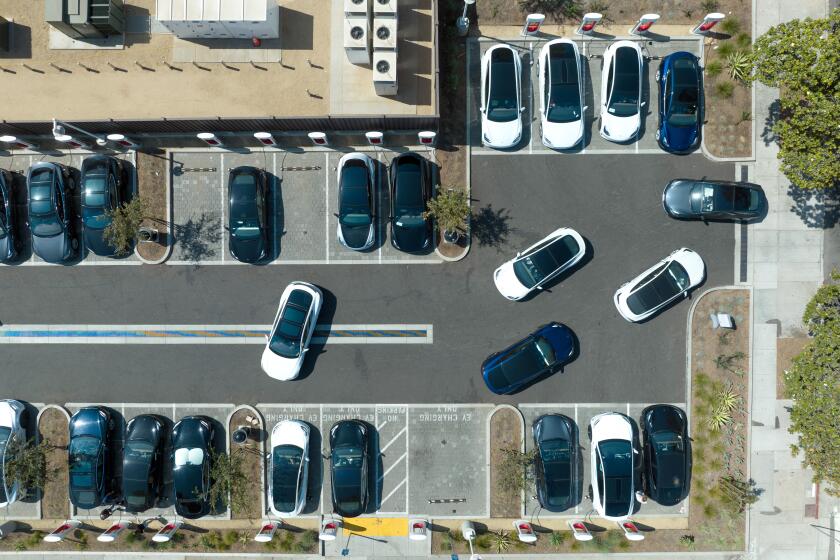Raising the Roof Over Modified Exhausts
- Share via
Ken Lee was astounded when the police officer handed him a ticket last year for having an illegal exhaust on his 1999 Honda Civic Si.
Sure, the car was significantly altered. The 29-year-old Baldwin Park computer technician had supercharged the stock 1.6-liter engine, replaced the standard 14-inch wheels with 17 inchers, added a powerful new stereo system and replaced the factory exhaust with a “cat-back” system from a popular aftermarket performance products manufacturer.
But the new exhaust, which replaced only those components that come after the stock catalytic converter so as not to alter the car’s emission system, was relatively quiet and certified by the manufacturer to meet noise standards in all 50 states.
So when Lee, who said he paid a $90 fine but was inexplicably allowed to keep his modified exhaust, heard early this year that the Specialty Equipment Market Assn. was looking for victims of a law many auto enthusiasts believe is discriminatory and arbitrary, he jumped at the chance to help.
That was in April, and Lee’s “illegal” exhaust was found in a SEMA-sponsored test to generate 87.8 decibels at the tailpipe, well below the official cutoff of 95 decibels measured from about a foot and a half away.
He was one of 10 motorists tested at SEMA’s offices in Diamond Bar that day--all of them recipients of citations for excessive noise or illegally modified exhaust systems. Nine of the systems tested under the limit, the trade group found.
“That’s because the enforcement policy currently used by police officers considers nearly all exhaust system modifications to be in violation, even where the noise levels are not excessive or unusual,” said Steve McDonald, director of government affairs for SEMA, which represents the $25-billion automotive performance and appearance-enhancing equipment industry.
Last year, manufacturers of specialty exhaust products--equipment other than replacement parts for stock systems--booked almost $360 million in retail sales, a 19% gain since 1996 that reflects the growing popularity of modified exhausts, often marked by oversized mufflers and tailpipe outlets.
SEMA’s test in April capped a four-year effort to change California law to provide a more objective system for issuing exhaust noise citations.
In August, Gov. Gray Davis signed a new measure, sponsored by SEMA, that says law enforcement personnel are required to tie noise violation citations to the 95-decibel standard that has existed since the late 1970s.
The law also says modified exhaust systems are legal as long as they meet the 95-decibel standard.
“That’s the first step,” said Christopher Kersting, executive vice president of the trade group.
Unfortunately, many enthusiasts say, when the new measure takes effect Jan. 1, the determination of “too loud” will still be left to individual law enforcement officers’ subjective judgment.
It should protect those, like Lee, who have received tickets simply because they have modified their exhausts. “The industry now can assure consumers who buy exhaust products that their products do meet the 95-decibel standard,” Kersting said. And tickets can be dismissed if the vehicle owner can show a judge that the system was in compliance--usually by presenting a certificate from the system manufacturer.
But the state Legislature has not yet seen fit to provide funds to equip law enforcement with noise-testing equipment, Kersting said.
So an officer who believes a car or truck is too noisy doesn’t have to whip out a decibel meter and measure the exhaust noise before writing a ticket. And the motorist still has no place to go, after receiving a citation, to get a certified test to prove that the exhaust wasn’t too loud.
“That’s the next step, and we’re still working hard on it,” Kersting said. “Without a test system, it’s still going to be hard to get a noise violation ticket dismissed.”
SEMA executives are meeting with the California Highway Patrol and other agencies to find a solution, he said. The trade group has even volunteered to donate decibel meters to be used at CHP offices in areas, such as the San Gabriel Valley, where young automotive enthusiasts abound and the number of citations for excessive noise and illegal exhaust systems exceeds the statewide norm.
So far, Kersting said, the agency has declined the offer, citing legitimate concerns about the cost of training and certifying officers to use the meters.
McDonald said SEMA had hoped to have language in the law establishing a system of state-sanctioned noise-test facilities, possibly in conjunction with state-approved smog test stations. But the financial crunch that came with the energy crisis this year eliminated the possibility of a state appropriation to fund such a system, he said, adding that “we opted to go for the best bill we could get during the legislative session.”
Lee said he and many of his friends would prefer to see law enforcement equipped with noise meters or at least to have local test stations where they could take their vehicles after being cited.
But if that doesn’t happen, he said, the new measure at least will mean he should no longer get tickets like the one that pulled him into the legislative process.
“When I was going through the checkpoint,” he said of his ticket, “they just looked and saw I had a modified system and wrote me up. They didn’t even ask me to rev the engine. They just assume it’s illegal because it’s not stock.”
*
Times staff writer John O’Dell covers autos for Highway 1 and the Business section. He can be reached at [email protected].






